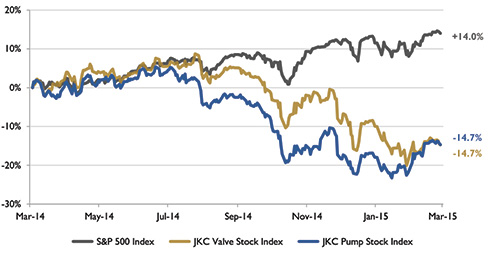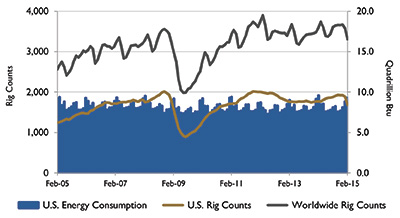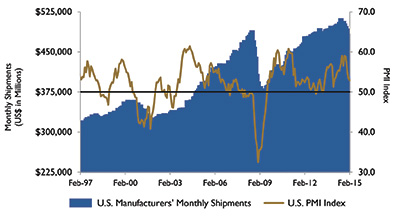The Jordan, Knauff & Company (JKC) Valve Stock Index was down 14.7 percent over the last 12 months, while the broader S&P 500 Index was up 14.0 percent. The JKC Pump Stock Index also decreased 14.7 percent for the same time period.1 The Institute for Supply Management’s Purchasing Managers’ Index (PMI) decreased to 52.9 percent in February. While a reading above 50 percent still suggests expansion in the manufacturing sector, this is the lowest index reading since January 2014. The average reading for the last 12 months is 55.7 percent. Likely factors for the decrease include falling energy prices, a stronger U.S. dollar, slow demand overseas and the issues at the West Coast docks. The Employment index fell 2.7 percent to 51.4 percent, the lowest point since 2013. On a brighter note, the backlog of orders increased to more than 50 percent after contracting in January.
 Figure 1. Stock indices from March 1, 2014, to Feb. 28, 2015 (Source: Capital IQ and JKC research. Local currency converted to USD using historical spot rates. The JKC Pump and Valve Stock Indices include a select list of publicly-traded companies involved in the pump and valve industries weighted by market capitalization.)
Figure 1. Stock indices from March 1, 2014, to Feb. 28, 2015 (Source: Capital IQ and JKC research. Local currency converted to USD using historical spot rates. The JKC Pump and Valve Stock Indices include a select list of publicly-traded companies involved in the pump and valve industries weighted by market capitalization.) Figure 2. U.S. energy consumption and rig counts (Source: U.S. Energy Information Administration and Baker Hughes Inc.)
Figure 2. U.S. energy consumption and rig counts (Source: U.S. Energy Information Administration and Baker Hughes Inc.) Figure 3. U.S. PMI and manufacturing shipments (Source: Institute for Supply Management Manufacturing Report on Business® and U.S. Census Bureau)
Figure 3. U.S. PMI and manufacturing shipments (Source: Institute for Supply Management Manufacturing Report on Business® and U.S. Census Bureau)
